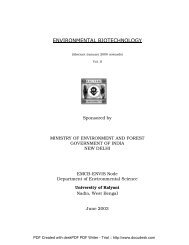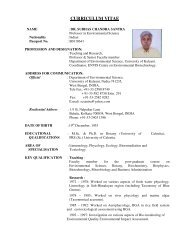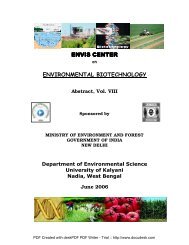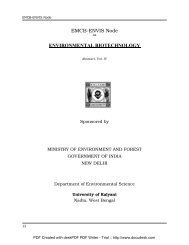EMCB-ENVIS Node ENVIRONMENTAL BIOTECHNOLOGY
EMCB-ENVIS Node ENVIRONMENTAL BIOTECHNOLOGY
EMCB-ENVIS Node ENVIRONMENTAL BIOTECHNOLOGY
Create successful ePaper yourself
Turn your PDF publications into a flip-book with our unique Google optimized e-Paper software.
<strong>EMCB</strong>-<strong>ENVIS</strong> Centre<br />
Organic chlorine compounds can be persistent environmental contaminants and may be<br />
accumulated through the food chain to the aquatic organisms, to fish and humans, depending<br />
basically on their hydrophobic properties. Consequently, there is an interest to measure these<br />
organic compounds from both the scientific and regulatory communities. The analytical essays<br />
have been improved for measuring specific organic chlorine compounds that present the most<br />
toxicological potential (polychlorinated biphenyls [PCBs], certain pesticides and dioxins),<br />
although they are tedious and time-consuming procedures. The existing tests to measure<br />
adsorbable organic halogens (AOX) or extractable organic halogens (EOX) do not distinguish<br />
the more hydrophobic organic chlorine matter. The intention of this paper is to make a review of<br />
the existing methods to measure the potentially bioaccumulating organochlorine compounds<br />
(OCs) from wastewater and propose a methodology to a standardisation procedure for complex<br />
mixtures of OCs in wastewater, such as pulp mill effluents. A new method has been proposed for<br />
determining the most hydrophobic part of the extractable organic halogens (EOXfob), the lowest<br />
reported value is 0.6 μg/l, expressed as chloride, and the relative standard deviation at 20 μg/l is<br />
7% on laboratory samples and 30% on real effluents. This new procedure could be a valuable<br />
tool to complement environmental risk assessment studies of wastewater discharges.<br />
M. Kantola, R. Purkunen, P. Kröger, A. Tooming, J. Juravskaja, M. Pasanen, S. Saarikoski,<br />
T. Vartiainen. (Department of Chemistry, University of Kuopio, FIN-70211, Kuopio, Finland.<br />
Department of Environmental Sciences, University of Kuopio, FIN-70211, Kuopio, Finland.<br />
Department of Chemistry, National Public Health Institute, 95, FIN-70701, Kuopio, Finland.<br />
Central Hospital of Rakvere, Rakvere, Estonia. Institute for Advanced Training of Physicians,<br />
St. Petersburg, Russia. Department of Pharmacology and Toxicology, University of Oulu and<br />
National Agency for Medicines, Oulu, Finland. Clinic of Gynaecology and Obstetrics,<br />
University Hospital of Kuopio, Kuopio, Finland). Accumulation of Cadmium, Zinc, and<br />
Copper in Maternal Blood and Developmental Placental Tissue: Differences<br />
between Finland, Estonia, and St. Petersburg. Environmental Research, 83(1) (2000),<br />
54-66.<br />
Cadmium, zinc, and copper from placental tissue and blood samples at the first trimester (n=64)<br />
and at term (n=152) were analyzed; the welfare of newborns and placental 7-eothoxycoumarin<br />
O-deethylase (ECOD) activities in vitro were determined. The study material was collected from<br />
Finland, Estonia, and Russia. The results demonstrate that Cd starts to accumulate in the placenta<br />
during the first trimester and that Zn and Cu contents were significantly higher at the first<br />
trimester than at term. Among nonsmokers a negative correlation was found between placental<br />
Cu content and birth weight of neonates. Among smokers a positive correlation between<br />
placental Zn content and birth weight and ECOD activity was found. The birth weights<br />
correlated inversely with the length of time the mothers smoked. The highest Cd concentrations<br />
were detected in the samples collected from St. Petersburg. The data demonstrate an inverse<br />
accumulation of Zn and Cd throughout the pregnancy in the placenta and maternal blood<br />
samples. Zn may act as a positive marker or even an enzymatic enhancement for the human<br />
placental vital functions. Smoking, parity, age, and especially the place of residence affect the<br />
Cd, Zn, and Cu contents and ratios in placenta and mother's blood.<br />
M. -L. Bouché, F. Habets, S. Biagianti-Risbourg, G. Vernet. (Laboratoire d'Éco-toxicologie,<br />
Faculté des Sciences, Université de Reims Champagne-Ardenne, Bâtiment Europol'Agro,<br />
1039, F-51687, Reims cedex 2, France. Laboratoire de Toxicologie des Métaux, Faculté de<br />
Pharmacie, Université de Reims Champagne-Ardenne, 51 rue Cognacq Jay, 51096, Reims<br />
cedex, France). Toxic Effects and Bioaccumulation of Cadmium in the Aquatic<br />
Oligochaete Tubifex tubifex. Ecotoxicology and Environmental Safety, 46(3) (2000),<br />
246-251.<br />
32<br />
PDF Created with deskPDF PDF Writer - Trial :: http://www.docudesk.com







